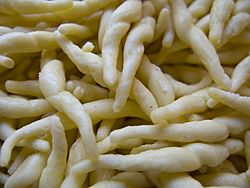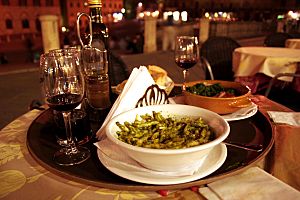Trofie facts for kids
 |
|
| Alternative names | Troffie, strofie, stroffie |
|---|---|
| Type | Pasta |
| Place of origin | Italy |
| Region or state | Liguria |
| Main ingredients | Durum wheat flour, water |
| Similar dishes | Trofiette |
Trofie is a special kind of pasta from Liguria, a region in Northern Italy. It is short, thin, and has a unique twisted shape. You might also hear it called troffie, strofie, or stroffie.
Contents
Where Does Trofie Come From?
Trofie pasta first appeared in a beautiful coastal area of Italy called Golfo Paradiso. This area is part of the Italian Riviera and includes towns like Recco, Sori, and Camogli.
For a long time, trofie was not very common in the big city of Genoa. In Genoa, the word trofie used to mean all kinds of gnocchi. But by the mid-1900s, this twisted pasta became very popular.
Today, trofie is a main dish in Ligurian cooking. There is also a smaller version of this pasta called trofiette.
What Does the Name "Trofie" Mean?

No one is completely sure how trofie got its name. One idea is that it comes from the Ligurian word strufuggiâ. This word means "to rub."
It makes sense because to make trofie, you rub and roll a small piece of dough. Another idea is that the name comes from an ancient Greek word, strophao, which means "to twist" or "to spin." This also describes how the pasta is made.
How Is Trofie Made?
Trofie pasta is made by hand in a special way. First, a small piece of dough is rolled on a flat surface. This makes a short, round piece of pasta with pointy ends.
Then, the pasta is twisted to create its unique shape. Each piece of trofie is usually about 2 to 3 centimeters (about 1 inch) long. It is about 4 millimeters (a little less than half an inch) wide.
When you cook trofie, it usually takes about 10 to 15 minutes. In Italian cuisine, trofie is most often served with a delicious green sauce called pesto.
See also
 In Spanish: Trofie para niños
In Spanish: Trofie para niños

